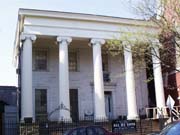Anyone wandering down quiet tree-lined Wayne Street, only a few blocks away from the chaos of Downtown, would pass remodeled brownstones, a few storefronts, and then, startlingly, a bright, white Greek Revival mansion, fronted by colossal wooden Ionic columns. It looks straight out of Gone With The Wind, and the Barrow Mansion, built more than 150 years ago, has survived war, development, and demographic changes, according to Andy Brody, a member of the adjacent St. Matthew’s Lutheran Church, the owners of the building. The mansion is a designated landmark on both the National and State Registers of Historic Places and sports one of the oldest bowling alleys in the state, which, legend has it, was built over 100 years ago. But the mansion is only one of several spots in the city that will be featured during “Preservation Week” (May 14-20), which the Jersey City Landmarks Conservancy hopes will get people thinking about the city’s heritage. “We were concerned that a lot of Jersey City history was being ignored” and possibly endangered, said John Gomez, president of the conservancy. And Gomez is doing something about it, sponsoring tours of the Pennsylvania Railroad’s Sixth Street Embankment, the Bergen Arches, and the Warehouse District, along with the Barrow Mansion and several other spots. During the week of May 14-20, the curious will be able to learn about the Hudson and Manhattan Railroad Powerhouse, on Washington Boulevard between First and Bay streets. Completed in 1906, the Powerhouse was recently nominated to be placed on a top ten list of New Jersey’s endangered historic sites. In 1908, Pres. Theodore Roosevelt helped power up the subway, which for the first time connected New York to New Jersey. It’s a big step for Gomez, who said talk has turned in the past year from demolishing the building to finding ways to preserve it. Gomez has provided a self-guided tour for the Powerhouse and other buildings in the warehouse district on his organization’s website: www.jerseycityhistory.net. But he warns people not to enter the buildings – most property is privately-owned. Gomez next points to the Bergen Arches, a 10-foot thick granite wall that supports railroad tracks, as an example of an engineering landmark and an urban animal refuge. It stretches from the foot of Dickinson High School in the west to Tonnele Avenue in the east. “The area becomes otherworldly,” he said. “And there’s great wildlife around the arches.” The fourth grade School No. 9 teacher, born and raised in the city, said he always had an interest in the city’s past, but only started the conservancy in January. “One day it just me: a lot of this history is endangered,” he said. Gomez worries that development, which he knows is inevitable, could wipe out major city landmarks. He points to the demolition of two national register city theaters in the last 10 years. “When you lose a lot of buildings, you have to wonder what’s wrong,” he said. The conservancy is a non-profit organization with a board comprised of Jersey City residents. Reservations will not be required for tours. Residents can merely show up and learn. The tours are as follows: The Bergen Arches, May 14, 10 a.m. (meet at 10th and Brunswick streets). The Warehouse District (self-guided; see website) which includes the Powerhouse. The Barrow Mansion, 83 Wayne St., May 20, doors open 12 to 4 p.m. The Pennsylvania Railroad Harsimus Stem Embankment, May 21, 1 p.m. Hudson-Bergen Light Rail Historical Tour, May 21, 4 p.m. (meet at Exchange Place stop). For more information on tour times and background on the sites, visit www.jerseycityhistory.net , or call (201) 420-1885.
Forgotten history: Residents can visit city’s landmarks during preservation week
